Australia is no exception to the global trend of expanding food delivery services, which has seen rapid expansion over the last decade. Home delivery services are becoming a more popular alternative to takeout and restaurants.
Recent global events may be helping to boost this trend, as more and more individuals choose to eat at home rather than go out to restaurants.
This article concisely overviews the Australian food delivery market STATS in 2022 and 2023. Let’s go right into this detailed account without further ado!
Online Food Delivery Statistics Australia
These are some eye-popping projections for 2022-2023 about Australia’s online meal delivery market. Here, we’ll examine each of them in further depth:

1. In 2020, 5.5 Million Australians Utilized Food Delivery Services.
The number of Australians who ordered meals to be delivered or picked up increased from 3.8 million in 2019 to 5.5 million a year later. In 2018, the sector was performing far worse than it had in previous years, with just 16.3 per cent of the population in Australia adopting its services.
2. Australian Consumers Spend over $2.6 Billion on Takeaway Meals
Australia’s rising demand for food delivery services is mirrored by a 2.1% rise in the price of fast food and takeout in 2021.
Australia’s average annual expenditure on takeout meal delivery is $1,590 per person. Regarding food delivery in Australia, Sydney takes the cake, earning about $2,000 per capita annually.
Those living in the Australian Capital Territory spent the most on takeaway in 202121, at AU$49 per month. On average, Queenslanders spend AU$ 42 per month on food delivery.
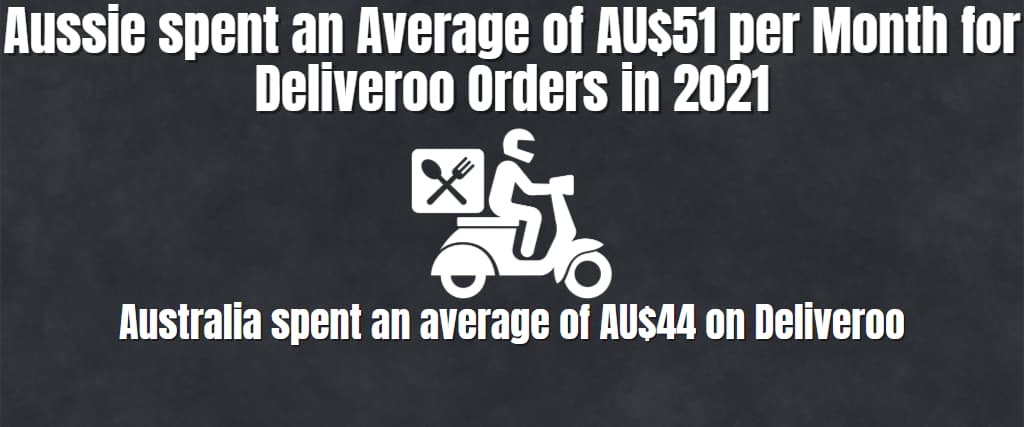
3. Aussie spent an Average of AU$51 per Month for Deliveroo Orders in 2021
People in Australia spent an average of AU$44 on Deliveroo, the most popular platform for takeaway that year. Menulog and Uber Eats came in close behind Deliveroo in terms of popularity.
4. 23.8% Of Australians in 2020 loved Italian Food
The percentage of Australians who like eating Indian (15.6%) or Thai (11.5%) cuisine is close behind the percentage of Australians who enjoy eating Chinese (7.7%). Although this happens, just 6.9% of all meal deliveries comprise sweets and drinks.
5. In 2020, 8.1 Million Australians Ordered Takeout From McDonald’s.
More than eight million customers over 14 years old dine at McDonald’s or order takeaway meals from the restaurant an average of once every four weeks.
This makes McDonald’s the most renowned fast eatery in Australia. KFC comes in a close second with 6.8 million customers, and then Hungry Jack’s attracts the business of 4.2 million Australians each year.

6. With a Market Share of 59.7% In 2020, Ubereats Led the Meal Delivery Sector in Australia.
Uber Australia is the most dominant company in terms of market share among all of the main competitors operating in the food delivery sector in Australia.
- Menulog: 12.1%
- Deliveroo: 17.5%
- Other: 10.7%
7. Delivery Commission Rates for Ubereats Vary From 20 to 35%.
Deliveroo, one of Australia’s top three meal delivery businesses, charges the most significant commission fees, which may account for up to 35 per cent of an order’s total revenue.
Although the delivery rates for UberEats and Menulog don’t vary much from one another, Menulog’s prices range from 14-30%, making it a more cost-effective option.
Despite this, they all use the same payment options, enabling clients to pay using their credit cards or PayPal accounts. In Australia, the opportunity to pay for meal delivery with cash is available; moreover, its use is rare.
8. In Australia, Just 9.1% Of Infant Food Orders Were Placed Online.
Although the numbers are relatively modest now, more and more Australians opt to have baby food delivered to their homes.
In 2019, less than 4% of Aussies placed orders for baby food online. In contrast, 94.4% of Australians preferred shopping in physical shops during the following year.
Nonetheless, in 2021, 7.6% of baby purchase decisions were made via delivery apps, a positive development for the digital baby delivery market for food. According to analysts’ projections, the growth rate is expected to accelerate even more in the years to come, reaching 15.1% in 2025.
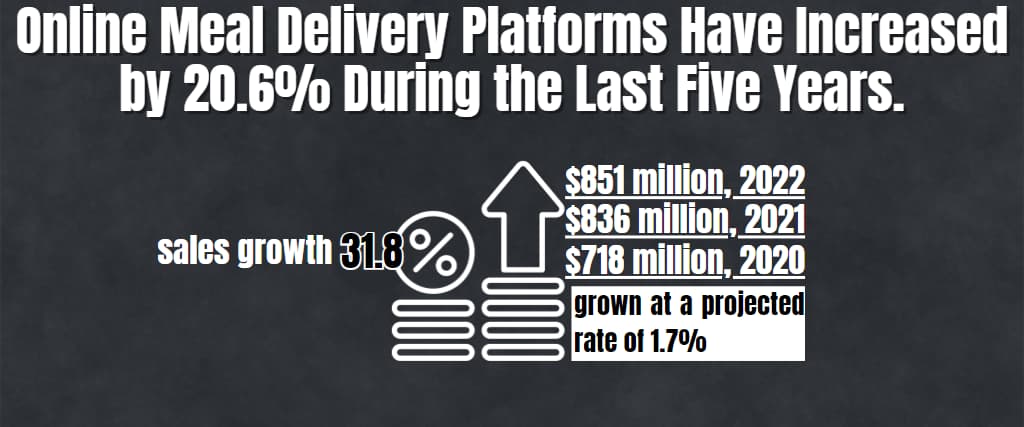
9. Online Meal Delivery Platforms Have Increased by 20.6% During the Last Five Years.
The market potential of the Australian meal delivery sector has significantly expanded, growing from $718 million as of 2020 to an astounding $836 million in the year after that.
This coincides with total sales growth over the net of 31.8%. The industry will have reached its pinnacle in 2022 with a sales volume of $851 million, which has grown at a projected rate of 1.7%.
10. Online Food Selling Earned $1.2 Billion in September 2021.
The amount of food sold via online retailers reached an all-time high in 2021. Since 2018, when the business got its peak revenue of $431 million, there has been an uptick in interest in shopping for groceries online.
After another year and a half, sales increased and eventually reached an astounding $855 million. The numbers continued to rise and reached their highest point in 2021 when they were projected to be worth $1.159 billion.
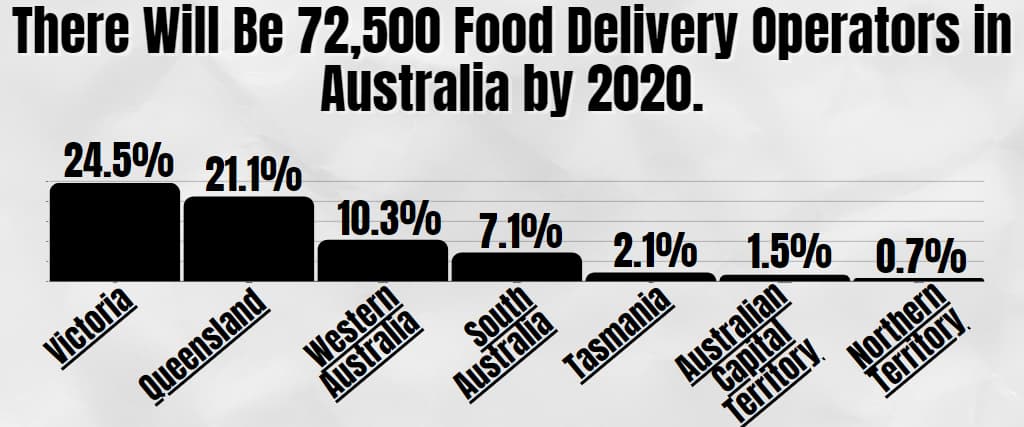
11. There Will Be 72,500 Food Delivery Operators in Australia by 2020.
Food delivery drivers are in great demand, and the Department of Labor predicts this trend will continue since they only need a little education, training, or experience. The workforce is projected to grow to 79,800 by the year 2025.
The most recent data shows that 32.8% of all food delivery operators in Australia are based in New South Wales.
- Victoria – 24.5%
- Queensland – 21.1%
- Western Australia – 10.3%
- South Australia – 7.1%
- Tasmania – 2.1%
- Australian Capital Territory – 1.5%
- Northern Territory – 0.7%
Remembering that this field is far from among the highest-paying ones is essential. The weekly wage for workers responsible for food delivery is $1,010, much less than the average wage of $1,460.
12. Just 10% Of Drivers Who Deliver Meals Are Female.
Since males make up 90% of the workforce in the food delivery business, the industry is primarily male.
Other companies, on the other hand, often have a female employment rate of 48%, representing over fifty per cent of the overall number of employed individuals.
13. A Food Delivery Driver in Australia Is Typically 39 Years Old.
Employment in the food delivery sector is dominated by millennials, who account for 19.5% of the workforce.
After those between the ages of 35 and 44, those between the ages of 45 and 54 make up a sizable portion of the food delivery market (18.9%), followed by those between the ages of 35 and 44 (16.1%).
In the workforce, 14.7% are young, 9.2% are between 55 and 59, and 2.3% are teenagers.
14. Delivery From Restaurants to Customers Has a Penetration Rate of 20.3%.
Both restaurant-to-consumer and platform-to-consumer delivery have shown a rise in user adoption. Although the platform delivery market is 12.9% penetrated in Australia, consumers have a stronger preference to order from restaurants.
By 2026, it is anticipated that 27.3% of restaurants and 17.4% of food delivery platforms will have used the technology.
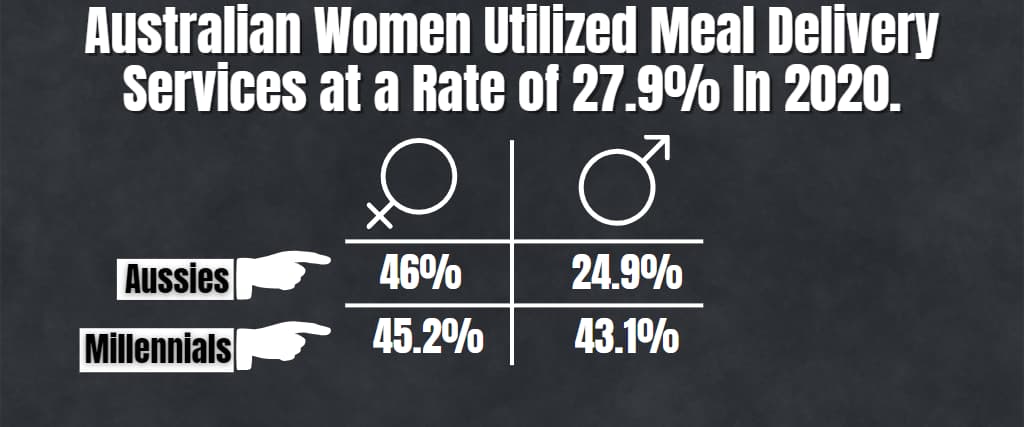
15. Australian Women Utilized Meal Delivery Services at a Rate of 27.9% In 2020.
Women in Australia are more likely to order meal delivery to spend the day doing anything other than cooking (46%) than males (24.9%). Millennials account for 45.2% of women and 43.1% of men in the consumer market.
16. About 40% Of Australian Millennials Would Have Used Food Delivery Services by 2020.
The latest data from Roy Morgan shows that young people in Australia, including millennials and Generation Z, are the ones who use food delivery services the most. These two age groups comprise over a third (37.2%) of all food delivery customers in the country.
This represents a rise in the percentage of users who are members of Generation Z (30.3%) and millennials (27.5%) in 2019. The following come after them:
- Gen X – 21.7%
- Baby Boomers – 11.4%
- Pre-Boomers – 9%
17. In Cities, 31.6% Of Australians Prefer to Have Food Delivered to Their Homes.
During the 2nd lockdown of the Covid-19 pandemic, 36.1% of Melbourne residents ordered meals online, surpassing Sydney’s 31.7% total.
This trend may be directly attributed to the increased awareness of the convenience of online food delivery that COVID-19 brought to Melburnians. With 29% of the population using such services, Perth must catch up.
Only 16.6% of the population in rural regions use food delivery services.
18. During COVID-19, 60% Of Individuals Utilized Meal Delivery Services.
The growth rate of meal-kit delivery services was from 8% to 36%. The proliferation of meal delivery services was directly responsible for this.
Those that used food delivery services during the epidemic wasted twice as much food as those who didn’t. There was a loss of $10.3 billion due to wasted food.

19. Market Size for Food Delivery Services Worldwide Is $130,2 Billion.
The worldwide market for food delivery is worth more than $100 billion, making Australia’s $851 million share look relatively small.
Moreover, as more individuals become aware of the benefits of technology, the online meal delivery market is projected to grow to US$223.7 billion.
20. Australia Had a 61% Increase in Restaurant Delivery Between 2019 and 2020.
At the height of the Covid-19 outbreak, restaurant-to-customer meal delivery skyrocketed in the United States by a whopping 95%. Australia is in close pursuit, ranking fourth with an expansion of almost 60%.
Russia (89%) and Canada (69%) were the only nations whose economies grew faster than Australia’s.
21. The Global Food Delivery Market Generates $460.11 Billion in Sales.
After a stressful day, coming home to a dinner already cooked for you might be a welcome relief. During the last five years, sales rose from $173.34 billion in 2018 to an expected $460 billion in 2022.
By 2026, the projected total is an eye-popping $625.64 billion. Australia, by contrast, is bringing in $3.05 billion this year and is projected to bring in $4.26 billion by 2020.
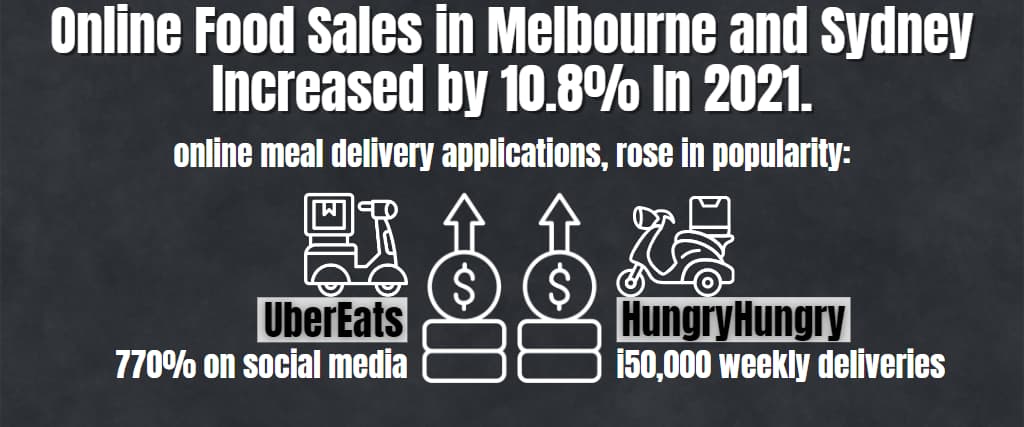
22. Online Food Sales in Melbourne and Sydney Increased by 10.8% In 2021.
As the epidemic unfolded, many individuals sought comfort in their computers. Online food sales jumped by 45% at the beginning of the Covid-19 issue, while traffic to Coles and Woolworths soared by 189%.
The use of online meal delivery applications, such as UberEats, also rose in popularity, with mentions of the service increasing by 770% on social media. Covid-19’s popularity boosted the development of even lesser-known enterprises, such as HungryHungry, which saw an increase of 50,000 weekly deliveries.
23. Marley Spoon Uses 70% Recycled Paper to Produce Their Packaging.
Twenty percent of the food consumed in Australia is lost or wasted annually, or 361 kg per person. The national recycling rate for plastics in Australia is under 9 percent.
Efforts have been made by Australian meal delivery businesses to reduce their environmental effect and improve the industry’s prospects for the future.
Hello Fresh, for instance, delivers pre-portioned meals in biodegradable paper bags. Youfoodz utilises plastic, but only recyclable plastic.
The most popular meal delivery systems, such as UberEats and Deliveroo, could be more sustainable, despite all the efforts to preserve the earth.
24. More Than 10,300 Delivery E-Bikes Are In Use In Melbourne Weekly.
The use of electric bikes for food delivery in Melbourne has increased recently. Compared to vehicles or motorbikes, they produce much less pollution and have several positive health effects.
The food delivery sector often employs throttle-controlled e-bikes rather than paddle-operated ones to make the drivers’ jobs easier. It is also demonstrated that many of these drivers exceed Australia’s legal speed limit of 25 kilometres per hour.
What is the Top Online Food Delivering Apps in Australia?
Owing to the present state of affairs, many owners of hospitality businesses have been forced to switch from in-house dining options to online ordering choices to maintain their company and, ideally, continue to employ personnel.
Platforms for ordering and delivering food enable restaurants to maximise conventional and digital marketing channels.
Thanks to online meal delivery systems, customers now have more options and convenience when ordering from various restaurants from their mobile phones or tablets.
Having meals delivered to your house anytime or location is simpler than ever. Several Internet delivery applications are now accessible; all you have to do is put one up for your company, gather orders, and have everything ready for delivery.
The primary concerns are the meal’s appearance, packaging, flavour, and delivery time.
While alternatives are advantageous, spending over 3% in fees to deliver meals may make it hard to profit.
Here is some helpful information on restaurant delivery and online ordering options:
1. Deliveroo
Deliveroo allows you to monitor the progress of your meal in real-time, and most of the time, the app guarantees delivery timeframes that are less than thirty minutes. This allows you to schedule the delivery of your food to coincide with your trip home after a hard day at work.
Since Deliveroo works with many restaurants, placing an order for your go-to comfort food, health food, or neighbourhood favourite is a breeze. Wait times in upscale restaurants are often longer, although you should anticipate this.
The Deliveroo app provides real-time tracking of the rider, and if your dinner contains alcoholic beverages, they can deliver those as well. Even catering solutions are available for events that take place at work.
2. Menulog
Menulog, a food delivery app based in Australia and New Zealand, has merged with EatNow to become one of the largest in the region. The company states that they deliver to 90% of Australian addresses, which is a sizable number when considering all the outlying communities.
Although UberEATS and Deliveroo don’t publicly disclose the exact commission rate they charge restaurants, Menulog is said to have some of the lowest rates.
Menulog is Australia’s most comprehensive food delivery service, serving 90% of households. Choose from over 11,000 restaurants offering 70 different cuisines to enjoy familiar dishes and new flavours delivered right to your door.
Menulog has quickly become one of the most popular digital meal delivery services thanks to its stellar user experience and an extensive list of participating restaurants. User reviews are included in the app; initially, many eateries provide a discount of 25%.
Menulog is delighted to take delivery orders that include alcoholic beverages. Within 24 hours of placing your order, if you find this same care product from an identical restaurant at a lower price, Menulog will refund the price difference plus an extra $10.
3. Uber Eats
UberEats aims to provide lightning-fast access to your favourite local restaurants’ menus. The mobile app has been revamped to provide a better overall experience. Visitors are drawn by the delicious food photos and encouraged to place online purchases.
You can have the local flavours you’ve been craving delivered to your home with “Uber speed”, thanks to Uber Eats, the food delivery service built on the back of the popular ride-sharing app.
Search for specific restaurants, foods, or cuisines, or browse the available options for nearby dining. You may use your Uber account to pay for meals and keep tabs on your driver as they go to your location.
4. Door Dash
This US-based corporation only began its operations in Australia in September 2019, although its services are now only offered in Melbourne and Sydney. You may search for qualifying restaurants using the DoorDash website or mobile app. Your meal will arrive when you place your order and safely pay for it online.
DoorDash is a firm that uses technology to link individuals with the finest their communities offer. Door Dash does this by giving local companies more power, which, in turn, creates new opportunities for people to make a living, find jobs, and have a place to live.
They began by making door-to-door delivery possible. However, they consider this the beginning of their mission to link people with possibilities in the form of clearer nights, better days, larger savings accounts, broader nets, and more robust communities.
5. Zomato
Discover hungry consumers and readily take their orders online after you’ve done so. Using Zomato Order can help you streamline the ordering process for takeaway and delivery.
Zomato is a website that offers information, menus, and user reviews of local restaurants. In some areas, Zomato also offers meal delivery choices from local restaurants partnered with the website.
6. EatNow
It takes two clicks, and your meal will be delivered to your door. EatNow has quickly become one of Australia’s most popular food applications because of its partnership with over 2,500 eateries. The notion swayed Matt Dyer, a former web developer, and he experimented with a company model that proved fairly profitable pretty quickly.
7. EASI – Food Delivery
The most popular Asian food delivery app in Australia is called EASI. Several well-known establishments, including cafés and grocery shops, have come to work with us. One of the most widely used applications for delivering meals in Australia is called EASI.
EASI delivers delectable dishes from over 12,000 restaurants to its customers’ homes. More than one million people in Adelaide, Melbourne, Sydney, Brisbane, Perth, Hobart, and Canberra are now being served by EASI in Australia. The EASI is now accelerating towards massive growth around the world.
8. Order Up
OrderUp!, another company with roots in Australia, offers companies and franchisees the ability to exercise complete creative control over their delivery operations. For instance, companies can decide what geographic region to distribute to and control their payments and delivery logistics.
At this time of need, Order Up is ready to provide you with an option for reasonably priced online ordering. Oder offers the option to allow Contactless Pick-Up & Delivery for their customers.
Make yourself stand out from the rest of the crowd, create a database you can use for future marketing, and retain more earnings from the money you’ve worked so hard to obtain.
9. Me&U
The new ordering and payment system in Australia. Me&U is a mobile, intelligent menu that fits in the palm of your hand and adjusts to the atmosphere of every restaurant you enter. It makes it possible for you to order meals and make payments smoothly.
No matter your location, Me&U is aware of your chosen mode of payment, dietary requirements, favourite recipes, and delicacies you, particularly like eating.
Me&U is enhancing the eating experience by making it better, more convenient, and more rapid than ever by combining Instagram’s aesthetic appeal with the practicality of Uber.
Consumers can now go into a restaurant, bar, or café, tap their way to placing an order, and quickly pay for their meal.
There will be no more need to raise your hands in the air to attract the waiter’s attention, no more need to stand in line, and no more need to spend time dividing the bill.
10. Hey You
In Australia, the app Hey You is the most widely used for placing coffee orders. You may use it to find nearby cafés and explore the menus of such cafes.
The app allows you to pre-pay and pre-order from your favourite restaurants and cafés before you arrive, and it saves your previous purchases from placing more orders efficiently. After that, hurry up and pick up your pastry and coffee so you may beat the line.
Find some new places to dine and drink in the neighbourhood of your house or home of business. Since you can make advance payments, there is no need to bring your money along if you want to pick up some coffee on your way out the door in the morning.
The best part is that you can earn loyalty perks with the Hey You app without dealing with the headache of cards and stamps.
Although technically, Hey You does not come to your door (yet), there are allegations that the firm located in Australia is testing out the delivery.
11. Bopple
Bopple is an app that links users to nearby eateries, where they can search for food, place orders, and make payments without leaving the app.
Almost a hundred of the most excellent restaurants and bars in the area collaborate with us to provide you with the finest local cuisine and libations. Bopple has it, and you may order it ahead of time if you have a desire.
Keep your seat, and we’ll have your order delivered to your table at the time of your choosing. The typical order processing time is 6 minutes.
If you have not received a notification that your package is ready for pickup or en route, you may check its status anytime. Your purchase confirmation has been sent to you for your convenience.
Boppl is a restaurant reservation app from London and a current home base in Brisbane. Customers may use their mobile devices to place orders for food and beverages and pay for them using the app.
Both before guests come and after they are seated, they may submit orders. Meaning diners place their orders whenever they’re ready rather than waiting for the wait staff to do so.
12. Skip
Another one for all you coffee enthusiasts are called Skip. It is a rival to Hey You and its selling point is that it makes ordering just as straightforward, right down to the very user-friendly UI.
If a coffee shop close to you always has a line stretching out the door when you walk by, it is in your best interest to investigate whether or not they have a listing in Skip.
If they do, you can avoid the crowds of unkempt people waiting in line and still get your hands on steaming Java.
13. Delivery Hero
Delivery Hero is all about well-liked options for lunch and supper; it’s the site you’d go to place an order from your neighbourhood pizza joint or from that fantastic Chinese restaurant down the street.
Significantly, you can use Delivery Hero to place food orders, which can be paid for with cash when the meal is delivered to your doorstep. This makes handling simpler than similar services, mainly if you buy food for a big party or need a credit card.
14. Postmates
Postmates is a meal delivery service now only available in the United States, but it should also make its way to Australia. This clever software boasts the industry’s most extensive network of on-demand resources.
In addition to meals, Postmates can transport groceries and booze to your home for your next get-together. The membership model is one of their favourite aspects of Postmates, and they hope more local food delivery companies will follow in the future.
If you sign up for Postmates, the monthly fee is around USD 8, but there are no additional fees for receiving infinite deliveries.
15. WooRestaurant
WooRestaurant is a plugin for WooCommerce that integrates your restaurant’s website with a full-fledged online meal ordering and delivery service.
Try out WooRestaurant’s menu navigation, cart addition, and checkout processes in action with the help of the live demo! The menu may have many different groups, allowing users to navigate between “pages” instantly without refreshing the website.
An individual picture and icons for attributes like heat intensity and vegetarian-friendliness may be assigned to each item on the menu.
Site-goers may place orders for in-store pickup or shipment. You can specify a minimum stock amount, a predetermined delivery fee, and operating hours. All these are essential for any severe restaurant to have on its website.
The flawlessness of the payment transaction and order correctness may be attributed to the fact that this meal delivery plugin was developed to function with the wildly popular WooCommerce plugin.
16. RestroPress
When ordering food online, WordPress users have access to RestroPress. It’s a free plugin for WordPress that makes it simple to include a food-ordering system into your site. You may take pickup and Delivery orders with ease with RestroPress.
You can quickly handle orders with RestroPress because of its intuitive frontend and backend interfaces, and it also includes a user dashboard for managing the user’s profile and charges.
17. DevFood
Their mission is to make it possible for food businesses to operate in a manner that is more effective, efficient, and trouble-free through the application of cutting-edge information technology, thoughtful user experience, and the lowest possible cost to the business.
18. GloriaFood
You only need this plugin to transform your eatery web page into an online company. You are provided with a restaurant menu, an online meal ordering and reservation system, and a user-friendly and straightforward interface.
Setting it up is a breeze; you won’t need coding skills. Follow the wizard’s instructions, add the food menu, and publish the button to place an order. You will be prepared to take the first food order in a few minutes.
19. WebPOS
WebPOS provides completely customisable web programs for online ordering that are lightning-quick, user-friendly and don’t charge commissions.
Your very own custom online ordering platform that is polished, appealing, and simple to use and which adapts to provide the optimal experience across desktop computers, mobile devices, and tablet computers.
20. FROLO
FROLO is a fee-free online ordering platform that allows restaurants that provide take-out and delivery services to accept orders online on their websites quickly and straightforwardly, without revealing any customer information or incurring costs.
The free cafeteria online ordering system by Marketing4Restaurants enables establishments that offer takeout and delivery services to their customers to quickly and easily accept online orders from their websites without incurring fees or sharing their customers’ personal information.
21. Foodora
Foodora is recognised as one of Australia’s premier food delivery applications since it sources its meals only from the nation’s most acclaimed eateries.
The application provides a selection of well-known restaurants to browse and a faster method for placing orders and delivering meals.
This mobile application for ordering food online is getting a lot of traction as a result of the fact that it can transport consumables from restaurants that, in general, do not deliver.
Wrapping Up
The post has accumulated extensive information on the meal delivery statistics for Australia for the years 2022-2023. It has thrown light on other key issues, such as the finest applications to deliver your meal and a great deal of additional information.